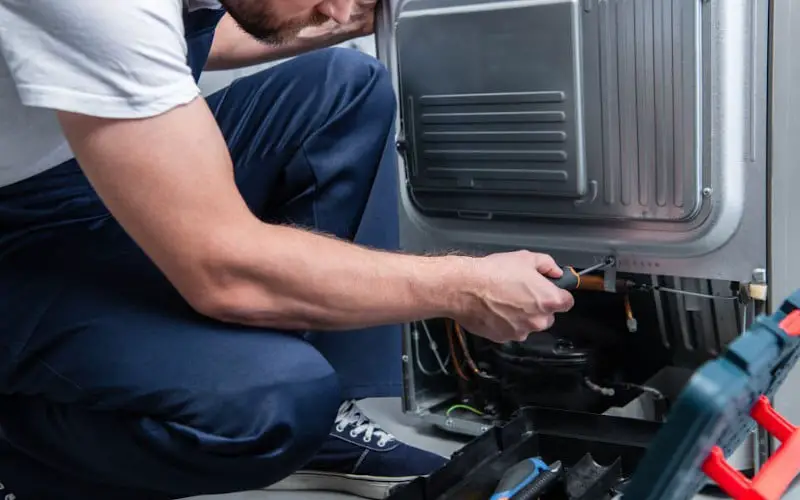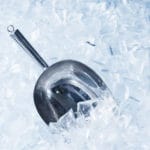Do you have a Samsung refrigerator that needs to be defrosted? If so, you’re in luck! This guide will teach you everything you need to know about how to defrost a Samsung fridge.
We’ll cover the different methods that can be used, as well as provide some helpful tips to make the process go as smoothly as possible.
Let’s get started!
How to Defrost a Samsung Refrigerator?
Make sure the refrigerator is turned off before you begin cleaning it. If the fridge is switched on while the door is open, more ice will be deposited inside. It’s possible that steam from the heated water will condense and form frost on the evaporator coils if large bowls of hot water are kept indoors.
Clear the house of any edibles and detachable shelves. While the refrigerator is defrosting, clean the shelves on the inside.
If your shelves become frozen due to ice, wait for it to thaw before attempting to move them again. Leave the doors open and carefully clean your Samsung refrigerator after melting all of the ice.
If the ice takes all day to melt, you’ll have to wait until the next day to use the pool again. Ice melting can be accelerated by utilizing the following tools and methods. If you fill a container with hot water and put it in the freezer, the process will be sped up.
Keep in mind that you should leave the door open.
However, it is critical to replenish the water every 10 minutes or so because it will rapidly chill. You may also use a wooden or plastic spoon, spatula, or anything similar to scrape the ice off of the walls, but be careful not to scratch the refrigerant lines.
A blow dryer or a heater fan can assist to speed up the procedure significantly. However, keep the electrical wires away from any water on the floor since this may harm the cooling system. Check that your blow dryer does not overheat throughout the process and that you do not overheat the refrigerator’s interior because this might damage it.
Alternatively, you can use a non-heating fan. The fan would circulate warm air inside the fridge, which would speed up the melting process.
Nevertheless, you won’t need to keep an eye on it; simply make sure that the cables aren’t in touch with water from the fridge.
If the ice is thin, a heated cloth wet with alcohol could be used to melt it.
Related: How to Clean a Samsung Refrigerator?
What Causes Frost Formation in a Samsung Refrigerator?
There are a number of reasons why your refrigerator might develop frost. Your daily routines cause the majority of these problems. The way you utilize your Samsung fridge has a significant influence on its long-term performance.
However, it’s conceivable that the creation of frost in your Samsung refrigerator is not due to any fault on your part.
In any case, let’s take a look at some of the potential causes of fridge frost generation:
The Presence of Warm Air
This is the major cause of ice formation in your Samsung refrigerator. When the evaporator coils in your fridge, which produce cold air, come into touch with damp or warm air, ice begins to form.
Then, how exactly does heated air get into your refrigerator in the first place?
You introduce fresh air into the system every time you open your refrigerator to retrieve something. Of course, completing this step rapidly will not allow for all of the warm air that will build up in the following days. However, if you open and shut your fridge several times each day, you might have a terrible frost wall within.
Bring anything you’ll need for the day with you to avoid going back into your refrigerator every few minutes. In this manner, you’ll be able to minimize the amount of warm air entering your fridge.
The Amount of Refrigerant in the System
Whether or not the quantity of refrigerant in it also determines frost forms in your refrigerator. Inadequate compressor compression causes a faulty cooling system due to low refrigerant levels.
As a result, rather than cold gas, warm gas is emitted. If you have an excessive amount of refrigerant in your refrigerator, it may seep into its coils and become a liquid. This can also lead to the formation of frost.
Parts That Have Been Damaged
If one or more of your refrigerator’s components are damaged, it’s conceivable that frost will form. The defrost thermostat and compressor are two of the most important elements that might cause frost to build up in your appliance.
Even if the defrost thermostat on your Samsung refrigerator is destroyed, the appliance will continue to cool, resulting in frost accumulation inside. If you find ice inside your recently purchased refrigerator, the compressor is most likely broken. Contact the manufacturer to request a replacement if this happens to you.
Furthermore, self-defrosting freezers should be left to chill for approximately 6 to 12 hours before being defrosted. They can defrost their equipment by turning on the defrost warmer and shutting off the compressor. If the compressor isn’t working correctly, this operation won’t happen.
Where Is the Forced Defrost Button on a Samsung Refrigerator?
A ‘control lock button’ is not found on a Samsung refrigerator. A forced defrost button, on the other hand, maybe found on almost every new Samsung fridge.
It’s in the back of your refrigerator, beneath the kickplate, or in the control panel. There are four metal terminals on the bottom of a defrost Samsung ice maker. If you notice something like this, it’s likely that you have a forced defrost Samsung ice maker. Consult your owner’s handbook for more information regarding the timer.
In a forced defrosted refrigerator, the Samsung ice maker will be switched to cooling defrost mode and then back to force defrost the Samsung ice maker when necessary. There won’t be any need to push any buttons on your Samsung fridge to make it freeze.
Should You Be Concerned About a Samsung Refrigerator’s Forced Defrost Alarm?
The long and straightforward answer is that you should not be concerned. When your Samsung refrigerator’s forced defrost function is on, it is common for it to beep.
To be more precise, it is critical to note that, in most cases, your Samsung refrigerator should buzz every second throughout the whole forced defrost procedure.
The alarm will continue to ring until your refrigerator has completed the forced defrost process and it has reverted to normal operating mode.
The fire alarm will cease beeping when the “FD” forced frozen process is completed. If you do another forced defrost cycle, you may rest assured that the fire alarm will go off again.
How to Fix Samsung Refrigerator Defrost Problem?
To repair a Samsung refrigerator defrost problem, first look for any issues with the defrosting system. The control board, defrost timer, heater assembly, a sensor with fuse and thermostat are all part of the system.
Start by checking the control board and timer. Check the control board with a multimeter if your fridge isn’t defrosting. If it’s not getting power, the control board is bad and will need to be replaced.
To check if the other components are functioning, use a multimeter to test for continuity. If the meter doesn’t move, there’s a problem with the components. Change the faulty component once you’ve found it. It’s usually preferable to get a professional to inspect and replace them.






